Shuttle SN27P2 SFF: AM2 gets the Tiny Treatment
by Jarred Walton on June 30, 2006 11:00 PM EST- Posted in
- Systems
We've run all of our gaming benchmarks in both normal (1280x1024/1280x960 without antialiasing or anisotropic filtering) and high quality modes (1600x1200 with 4xAA/8xAF). We have not included results from SLI systems, because for this form factor you really can't match the performance of a top SLI/CrossFire configuration. At the very least, you would need to upgrade to a micro ATX motherboard and case so that you have the option of running to dual slot GPUs. In general, we consider most of these gaming benchmarks as more of a sanity check for SFF systems; i.e., are you really willing to give up gaming performance in order to go with a smaller case? Hard-core gamers would probably prefer a larger system in most instances, due to the added expansion options, but a lot of people would be happy with even 7600 GT performance levels.
Standard Quality
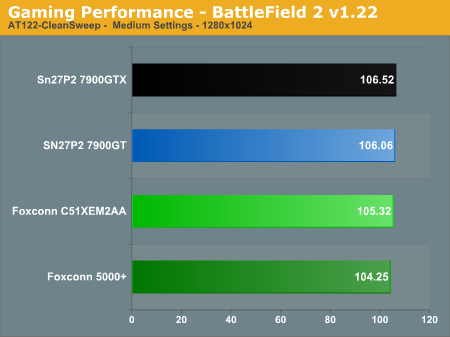
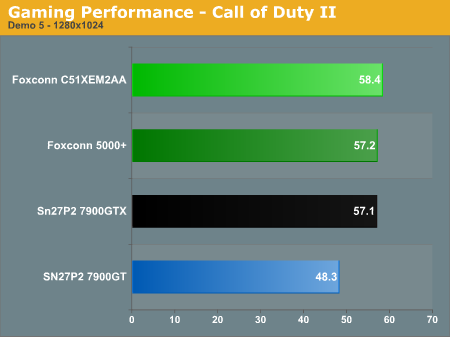
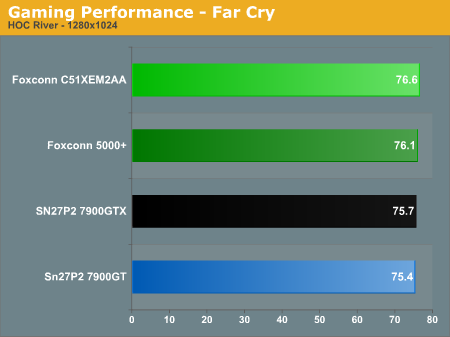
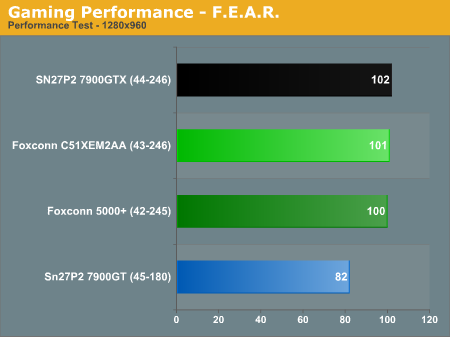
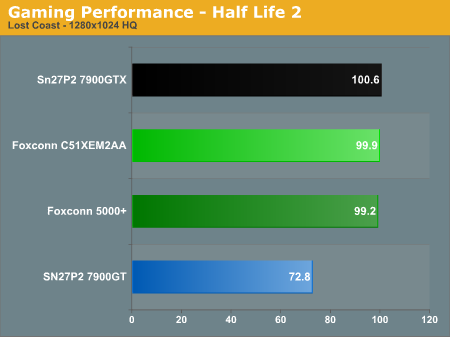
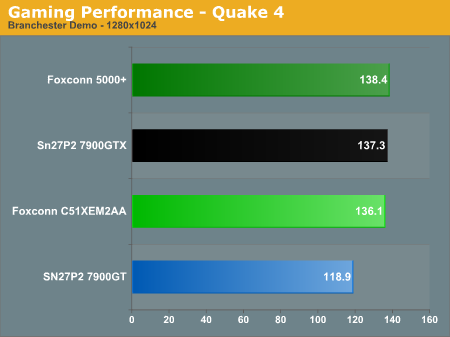

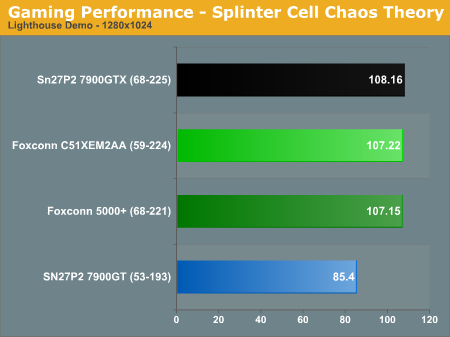
High Quality
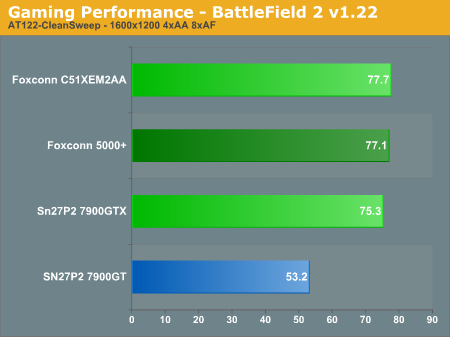
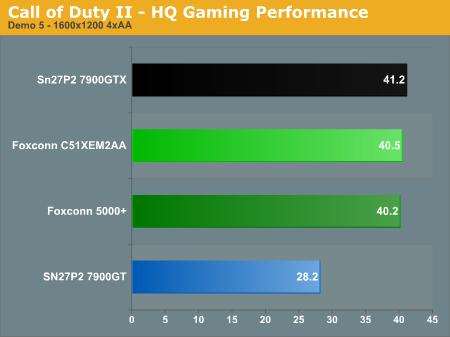
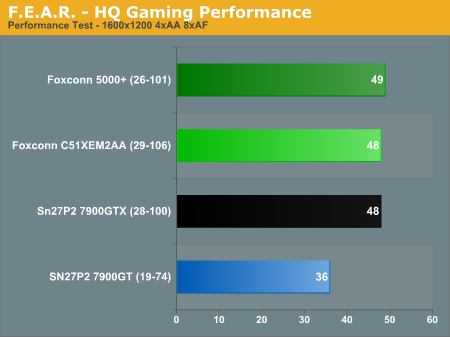
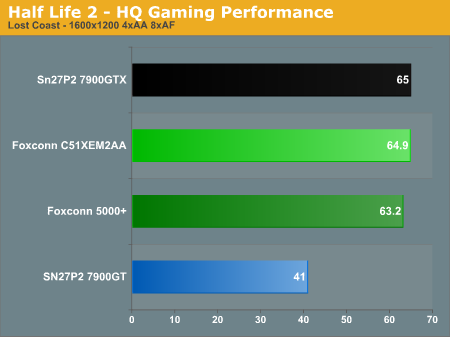
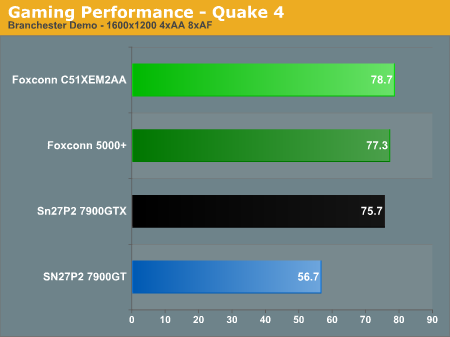
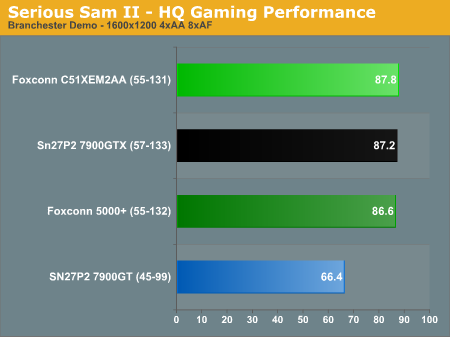
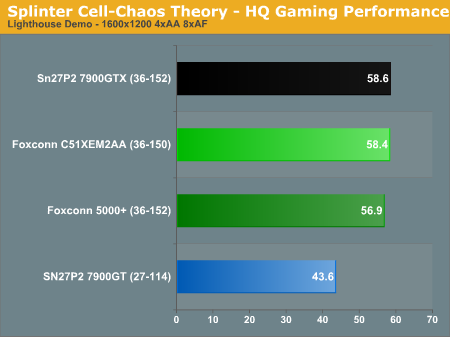
It's not too surprising that the 7900 GT comes in at the bottom of the pack in nearly every benchmark. There are a few games, however -- especially at lower detail levels -- where the CPU is still the primary bottleneck. The particular level that we benchmark in Far Cry is an example of a CPU limited game. Other games like F.E.A.R. are the exact opposite, depending almost entirely on a fast graphics subsystem to get maximum performance. Provided you can live with single GPU performance (and future GPUs will improve performance without requiring multiple cards or slots), the SN27P2 is more than capable of functioning as a moderate gaming platform. It's also far easier to tote it around to LAN parties compared to a large ATX case.
We won't bother with the audio, networking, USB, or FireWire charts, as there is nothing really noteworthy in any of them. The ALC882 audio codec performs just as well in the SN27P2 as it does on ATX motherboards, which is to say that an X-Fi card is still going to be better overall, particularly for gaming. Gigabit networking worked without a hitch, as did FireWire and USB peripherals. We used the system to record quite a few World Cup Football matches via the FireWire port, coming through an HDTV enabled cable set-top box. (Such a configuration may not be as convenient as using a TV tuner card, but for occasional TV recordings it is sufficient for my needs.) Playback of HD content was definitely better on the SN27P2 than on something like the AOpen MiniPC.
Standard Quality








High Quality







It's not too surprising that the 7900 GT comes in at the bottom of the pack in nearly every benchmark. There are a few games, however -- especially at lower detail levels -- where the CPU is still the primary bottleneck. The particular level that we benchmark in Far Cry is an example of a CPU limited game. Other games like F.E.A.R. are the exact opposite, depending almost entirely on a fast graphics subsystem to get maximum performance. Provided you can live with single GPU performance (and future GPUs will improve performance without requiring multiple cards or slots), the SN27P2 is more than capable of functioning as a moderate gaming platform. It's also far easier to tote it around to LAN parties compared to a large ATX case.
We won't bother with the audio, networking, USB, or FireWire charts, as there is nothing really noteworthy in any of them. The ALC882 audio codec performs just as well in the SN27P2 as it does on ATX motherboards, which is to say that an X-Fi card is still going to be better overall, particularly for gaming. Gigabit networking worked without a hitch, as did FireWire and USB peripherals. We used the system to record quite a few World Cup Football matches via the FireWire port, coming through an HDTV enabled cable set-top box. (Such a configuration may not be as convenient as using a TV tuner card, but for occasional TV recordings it is sufficient for my needs.) Playback of HD content was definitely better on the SN27P2 than on something like the AOpen MiniPC.










17 Comments
View All Comments
Calin - Monday, July 3, 2006 - link
Most any ATX case will be quiter and possibly cooler inside than one of those SFF computers. However, they will be twice as big (or more). If that's ok with you, that's great - ATX all the way. If not, a laptop or a SFF certainly makes sense (even if the price is much better on the full ATX front).JarredWalton - Monday, July 3, 2006 - link
I don't know - it depends on the ATX case you're talking about and how many fans you want to install. If you install two or three case fans (or more) and they aren't temperature controlled, a lot of the less expensive ATX cases will be louder than many SFF cases. Lower quality power supplies will also make a lot of noise. If you don't want a big case, and you are interested in getting an extremely easy to set up bare-bones system, SFF computers are really very nice.I do wish prices were about $100 lower, however. $300 for a SFF I can justify; $400+ is a lot more difficult to stomach. For that much money, you can get a good power supply, motherboard, and pretty much any case that you want. I suppose part of it has to do with economies of scale; I don't know how many SFF cases Shuttle has sold, but I doubt they sell as many SFFs someone like ASUS would sell motherboards. That means all of their R&D costs that go into creating a smaller case have to be passed on as a larger percentage of the price.
JarredWalton - Saturday, July 1, 2006 - link
There was no opinion given on which CPU to choose, was there? I simply stated (and this is the expanded version) that even if you're going to buy AMD anyway and couldn't care less about Core 2 Duo, AMD has price cuts scheduled for July 24th so you can pick up an X2 CPU for a lot less than current prices. Here's my opinion:Core 2 Duo will be faster than anything AMD has to offer at least in the short term. AMD X2 will cost less at most (all?) price points, and in some cases (gaming), you're probably GPU limited either way since the current maximum for an SFF is going to be the 7950 GX2. I expect Shuttle will have the SD37P2 out some time after C2D launches, but since they're already 1 month behind the AM2 launch and you still can't purchase the SN27P2, that trend will likely continue and the SD37P2 won't be available until probably early September or so. (I could very well be wrong on that account, but I'm simply going by recent history.)
Which is the better choice? As you have so clearly demonstrated, that's a matter of personal taste. Some people are only going to buy AMD at present; others will only buy Intel. Most would like to buy whichever offers the best performance at a specific price point. I would guess that AMD will be competitive in the price/performance area even if C2D is faster overall, so in the end they get what they're happy with. I still wouldn't purchase an AM2 chip until those price cuts take affect.
VooDooAddict - Saturday, July 1, 2006 - link
Simply.
Will the 7950 Fit?
Does the BIOS support the card?
Can the powersupply keep it running with 2 gigs of RAM and a AMD 5000+?
As soon as I saw the 7950 anouncement all I could think about was building a new SFF system around it.
JarredWalton - Saturday, July 1, 2006 - link
I don't have one available, but my understanding is just about any motherboard with an X16 slot will work with the 7950 GX2. Since I managed to install a 7900 GTX in the SN37P2, I'm pretty sure the GX2 is actually a bit smaller overall, so it will certainly fit. Is it compatible? Well, the SN27P2 uses an NVIDIA chipset, so if it's *not* compatible, NVIDIA has a serious problem with support of GX2. In other words, I'm 99% certain that it will work.VooDooAddict - Monday, July 3, 2006 - link
I didn't think the issue was the chipset ... I thought it was the BIOS.JarredWalton - Monday, July 3, 2006 - link
Right, the BIOS needs to support non-graphics devices in the X16 slots. My point is that if a board using NVIDIA's chipset doesn't support NVIDIA's top GPU, what's the chance of getting everyone else to support it?